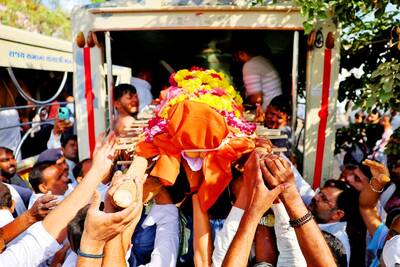Heavy rain on Thursday in Haiti’s capital worsened squalid camps and highlighted the urgent need for shelter after last month’s quake, as the UN called for a record US$1.44 billion in aid.
More than a month after what some experts say could be the worst natural disaster in modern history, aid workers are racing against time to try to distribute enough tarpaulins to the more than 1 million left homeless.
Even those will provide only basic protection when the rainy season begins in May, aid officials said.
“Everything was wet,” said Joseph Jean-Luc, 30, as he helped a friend build a shelter by nailing together branches at a massive tent city that used to be a country club golf course overlooking Port-au-Prince.
Many spent Thursday washing mud-caked clothes, drying out mattresses and waiting in line for vaccinations. Others dug small trenches around makeshift tents in a bid to keep them from flooding again.
Reflecting the massive needs in what was already the poorest country in the Americas before the quake, UN Secretary-General Ban Ki-moon launched the world body’s largest ever appeal for humanitarian aid.
The request for US$1.44 billion to assist earthquake victims, a year-long appeal, includes a US$577 million request made in the aftermath of the devastating quake.
“As the rainy season is coming to Haiti, it will be extremely important to provide on a priority basis shelters, sanitation and other necessary humanitarian assistance,” Ban said in New York.
He spoke at a ceremony attended by his special envoy for Haiti, former US president Bill Clinton, and UN humanitarian chief John Holmes.
“We are with you,” Ban said to the people of Haiti. “We will help you to recover and rebuild.”
Clinton stressed the need for donors to follow through on their commitments.
“Pledge less and give it, and do it sooner than later,” Clinton said.
Clinton also promised transparency in the use of donated funds by posting how the money is spent on the haitispecialenvoy.org Web site.
Previously, the largest natural disaster appeal — US$1.41 billion — was issued in 2005 in the wake of the Indian Ocean tsunami.
Distribution of shelter material got off to a slow start following the massive earthquake, in part because of debate over the best strategy, and aid workers are now rushing to hand out tarpaulins ahead of the heavy rains.
UN officials say only about 272,000 people have received shelter materials so far following the disaster that killed more than 217,000 people.
Canadian Deputy Commanding General Nicolas Matern of the Haiti Joint Task Force said tarpaulin deliveries were being ramped up to try to reach all of the homeless with some form of shelter before the rainy season.
Officials are hoping to carry out a similar effort being done with food distribution, though the problem is vastly more complicated because of camp conditions, among other issues.
After a stumbling start, aid workers launched a major food distribution push at the end of last month and a total of more than 2 million people have now been reached with some kind of food, UN officials say.
Many Haitians, however, still say they have received nothing, while some of those that have benefited from distributions say they have only been given a limited supply of rice.
Matern acknowledged tarpaulins were only basic protection in the rainy season, but said it was the best strategy to try to reach everyone since the needs were so daunting.
“There is an impression out there that we will be able to turn around and build transitional shelter with framing and all that by the rainy season, forget it,” he said. “It ain’t going to happen. We don’t have the resources nor the time to do it.”

POLITICAL PRISONERS VS DEPORTEES: Venezuela’s prosecutor’s office slammed the call by El Salvador’s leader, accusing him of crimes against humanity Salvadoran President Nayib Bukele on Sunday proposed carrying out a prisoner swap with Venezuela, suggesting he would exchange Venezuelan deportees from the US his government has kept imprisoned for what he called “political prisoners” in Venezuela. In a post on X, directed at Venezuelan President Nicolas Maduro, Bukele listed off a number of family members of high-level opposition figures in Venezuela, journalists and activists detained during the South American government’s electoral crackdown last year. “The only reason they are imprisoned is for having opposed you and your electoral fraud,” he wrote to Maduro. “However, I want to propose a humanitarian agreement that

ECONOMIC WORRIES: The ruling PAP faces voters amid concerns that the city-state faces the possibility of a recession and job losses amid Washington’s tariffs Singapore yesterday finalized contestants for its general election on Saturday next week, with the ruling People’s Action Party (PAP) fielding 32 new candidates in the biggest refresh of the party that has ruled the city-state since independence in 1965. The move follows a pledge by Singaporean Prime Minister Lawrence Wong (黃循財), who took office last year and assumed the PAP leadership, to “bring in new blood, new ideas and new energy” to steer the country of 6 million people. His latest shake-up beats that of predecessors Lee Hsien Loong (李顯龍) and Goh Chok Tong (吳作棟), who replaced 24 and 11 politicians respectively

Young women standing idly around a park in Tokyo’s west suggest that a giant statue of Godzilla is not the only attraction for a record number of foreign tourists. Their faces lit by the cold glow of their phones, the women lining Okubo Park are evidence that sex tourism has developed as a dark flipside to the bustling Kabukicho nightlife district. Increasing numbers of foreign men are flocking to the area after seeing videos on social media. One of the women said that the area near Kabukicho, where Godzilla rumbles and belches smoke atop a cinema, has become a “real

‘WATER WARFARE’: A Pakistani official called India’s suspension of a 65-year-old treaty on the sharing of waters from the Indus River ‘a cowardly, illegal move’ Pakistan yesterday canceled visas for Indian nationals, closed its airspace for all Indian-owned or operated airlines, and suspended all trade with India, including to and from any third country. The retaliatory measures follow India’s decision to suspend visas for Pakistani nationals in the aftermath of a deadly attack by shooters in Kashmir that killed 26 people, mostly tourists. The rare attack on civilians shocked and outraged India and prompted calls for action against their country’s archenemy, Pakistan. New Delhi did not publicly produce evidence connecting the attack to its neighbor, but said it had “cross-border” links to Pakistan. Pakistan denied any connection to